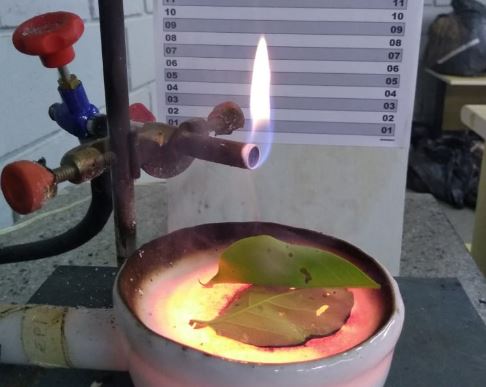Flammability assessment of Cerrado plant species
DOI:
https://doi.org/10.20873/jbb.uft.cemaf.v9n2.americoKeywords:
Epiradiator, flammability index; Brazilian savannah; forest firesAbstract
Fire can cause damage and benefits to an ecosystem, and this relationship is influenced by two main factors: local weather conditions and fuel material characteristics. One of the main factors influencing the combustion process is the flammability of fuels, and its understanding is essential for the prevention of forest fires. Therefore, this study aimed to evaluate the flammability potential of Tabebuia aurea (Silva Manso) Benth. & Hook.f. ex S.Moore, Pseudobombax grandiflorum (Cav.) A. Robyns, Dimorphandra mollis Benth , Chytraculia concinna (DC.) Kuntz, Eriotheca gracilipes (K. Schum.) A. Robyns and Qualea multiflora Mart. of cerrado sensu stricto and to indicate the species with the greatest potential to help prevent forest fires. The work was carried out at the Forest Research Laboratory at the Center for Environmental Monitoring and Fire Management (CeMAF) at the Federal University of Tocantins where flammability tests were conducted to evaluate ignition time, ignition frequency, combustion duration, combustion index and flammability value of the combustible materials, for each species studied, 50 firings were performed in a epiradiator, each burn consisted of 1 ± 0.1 g of green combustible material. Based on the obtained data it was verified that among the studied species the one that showed the highest flammability index was Eriotheca gracilipes, on the other hand, Tabebuia aurea, Pseudobombax grandiflorum and Dimorphandra mollis species are considered to be weakly flammable, classifying them as potential for use in forest fire prevention.
References
Batista AC, Biondi D. Avaliação da inflamabilidade de Ligus-trum licidum Aiton (Oleaceae) para uso potencial em corti-nas de segurança na região sul do Brasil. Revista Brasileira de Ciências Agrárias, v. 4, n. 4, p. 435-439, 2009.
Batista AC. Incêndios florestais. Recife: Imprensa Universitá-ria da UFRPE, 115 p. 1990.
Coutinho LM. O cerrado e a ecologia do fogo. Ciência hoje, v. 12, n. 68, p. 23-30, 1990.
De Lillis M, Bianco PM, Loreto F. The influence of leaf water content and isoprenoids on flammability of some Mediterra-nean woody species. Int J Wildland Fire, v. 18, p. 203-212, 2009.
Gill AM, Moore PHR. Ignitability of leaves of Australian plants. Canberra: CSIRO Plant Industry. 34 p. 1996.
Hernando CL. Combustibles forestales: inflamabilidad. La defensa contra incendios forestales, fundamentos y expe-riencias. McGraw-Hill, New York, p. 3-6, 2000.
Kovalsyki B, Takashina IC, Tres A, Tetto AF, Batista AC Inflamabilidade de espécies arbóreas para uso em cortinas de segurança na prevenção de incêndios florestais. Pesquisa Florestal Brasileira, v. 36, n. 88, p. 387-391, 2016.
MINISTÉRIO DO MEIO AMBIENTE (MMA). Consulta por: O Bioma Cerrado. Disponível em: <http://www.mma.gov.br/biomas/cerrado> Acesso em: 16 de abril. 2016.
Miranda HS, Bustamante MMC, Miranda AC. The Cerrados of Brazil: ecology and natural history of a neotropical sa-vanna. The fire factor. p. 51-68, 2002.
Oliveira PS & Marquis RJ. The cerrados of Brazil: ecology and natural history of a neotropical savanna. Columbia Uni-versity Press, 2002.
Petriccione M. Infiammabilità della lettiera di diverse specie vegetali di ambiente mediterraneo. 2006. 48 f. Tese (Doutorado em Biologia Aplicada) - Dipartimento di Biologia Strutturale e Funzionale, Università Degli Studi Di Napoli Federico II, Napoli. 2006.
Pivello VR. The Use of Fire in the Cerrado and Amazonian Rainforests of Brazil: Past and Present. Fire Ecology, v. 7, 2011.
Ribeiro JF, Walter BMT. Fitofisionomias do bioma Cerrado. Embrapa Cerrados-Capítulo em livro científico (ALICE). p. 89-166, 1998.
SEPLAN/TO. Atlas do Tocantins: Subsídios ao planejamento da gestão territorial. 2002.
Soares RV, Batista AC, Tetto AF. Incêndios florestais: contro-le, efeitos e uso do fogo. Curitiba, 2ª edição revisada, 255 p. 2017.
Souza MA, Vale, AT. Levantamento de plantas de baixa in-flamabilidade em áreas queimadas de cerrado no Distrito Federal e análise das suas propriedades físicas. Univer-sidade de Brasília, 2019.
Valette JC. Inflammabilities of Mediterranean species. Forest fire risk and management, v. 16719, p. 51-64, 1997.
White RH, Zipperer WC. Testing and classification of individ-ual plants for fire behaviour: plant selection for the wildland–urban interface. International Journal of Wildland Fire, v. 19, n. 2, p. 213-227, 2010

Downloads
Published
How to Cite
Issue
Section
License
Copyright (c) 2024 - Journal of Biotechnology and Biodiversity

This work is licensed under a Creative Commons Attribution 4.0 International License.
Authors who publish with this journal agree to the following terms:
Authors retain copyright and grant the journal right of first publication with the work simultaneously licensed under a Creative Commons Attribution License (CC BY 4.0 at http://creativecommons.org/licenses/by/4.0/) that allows others to share the work with an acknowledgement of the work's authorship and initial publication in this journal.
Authors are able to enter into separate, additional contractual arrangements for the non-exclusive distribution of the journal's published version of the work (e.g., post it to an institutional repository or publish it in a book), with an acknowledgement of its initial publication in this journal.
Authors are permitted and encouraged to post their work online (e.g. in institutional repositories or on their website) prior to and during the submission process, as it can lead to productive exchanges, as well as earlier and greater citation of published work (Available at The Effect of Open Access, at http://opcit.eprints.org/oacitation-biblio.html).


